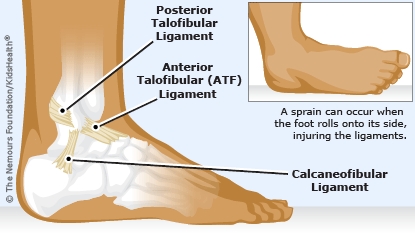- Parents Home
- Para Padres
- A to Z Dictionary
- Allergy Center
- Asthma
- Cancer
- Diabetes
- Diseases & Conditions
- Doctors & Hospitals
- Emotions & Behavior
- First Aid & Safety
- Flu (Influenza)
- Food Allergies
- General Health
- Growth & Development
- Heart Health & Conditions
- Homework Help Center
- Infections
- Newborn Care
- Nutrition & Fitness
- Play & Learn
- Pregnancy Center
- Preventing Premature Birth
- Q&A
- School & Family Life
- Sports Medicine
- Teens Home
- Para Adolescentes
- Asthma
- Be Your Best Self
- Body & Skin Care
- Cancer
- Diabetes
- Diseases & Conditions
- Drugs & Alcohol
- Flu (Influenza)
- Homework Help
- Infections
- Managing Your Weight
- Medical Care 101
- Mental Health
- Nutrition & Fitness
- Q&A
- Safety & First Aid
- School, Jobs, & Friends
- Sexual Health
- Sports Medicine
- Stress & Coping
Ankle Sprains
What Is an Ankle Sprain?
An ankle sprain is when the ligaments that support the ankle get overly stretched or torn. It can happen when you step in a hole, twist your ankle while walking or running, or put your weight down on your foot awkwardly.
When most ankle sprains happen, the ankle is flexed and inverted (the foot turned inward toward the opposite foot). Ankle sprains are common, making up 25% of all sports-related injuries.
With rest and proper treatment, most ankle sprains heal within 4–6 weeks. But some can take longer.
What Are the Signs & Symptoms of an Ankle Sprain?
The signs of an ankle sprain depend on how serious it is. Common symptoms include:
- pain
- soreness
- swelling
- trouble bearing weight or walking on the ankle
- bruising
What Causes Ankle Sprains?
Most ankle sprains happen when the ankle twists, or when the foot rolls onto its side. Most happen during athletic activities. But you don't have to be playing sports to injure an ankle — sprains can happen from taking an awkward step or tripping on the stairs.

How Are Ankle Sprains Diagnosed?
To diagnose ankle sprains, doctors ask about the injury and do an exam. They'll check the bones and soft tissue of the ankle, watch the person's range of motion, and do strength tests.
Sometimes, the doctor may order an X-ray or other imaging study to see if there are other injuries, such as a broken bone.
How Are Ankle Sprains Treated?
Treatment for an ankle sprain usually includes:
- protecting the ankle by taping, wearing a lace-up ankle brace, or ankle splint
- rest to prevent reinjury and limit swelling. How long somebody needs to take it easy depends on the injury. If no ligaments tore, 10–14 days might be long enough.
- pain medicine
- treatments to help with swelling such as:
- ice wrapped in a towel placed on the area for about 20 minutes every 1–2 hours
- an elastic bandage wrapped around the area or elastic sleeve to provide compression
- raising the injured area
- warm compresses or a heating pad (only after the swelling goes down)
- when the pain and swelling are better, stretching exercises
- before returning to activity, strengthening exercises
Doctors may treat a more serious ankle sprain with a splint or temporary cast. Very rarely, a person might need surgery.
Can I Go Back to Sports?
If you have an ankle sprain, you'll probably need to take some time off from sports and other strenuous physical activities. Make sure your sprained ankle is completely healed first.
You can go back when:
- The swelling goes down.
- The sport does not cause pain.
- The doctor says it's OK.
- You can bear weight without a limp.
- You have your full range of motion.
- Your strength returns to normal.
Can I Prevent a Sprained Ankle?
It's impossible to prevent all ankle sprains. But these tips can make another one less likely:
- Stretch regularly to keep your ankles flexible.
- Do ankle range of motion and strengthening exercises to keep your muscles strong.
- Always warm up before playing sports, exercising, or doing any other kind of physical activity.
- Watch your step when you're walking or running on uneven or cracked surfaces.
- Don't overdo things. Being tired can make an injury more likely.
- Use tape, lace-up ankle braces, or high-top shoes to support the ankle.
- Wear shoes that fit well. Tie any laces and close any Velcro or other straps to make the shoes as supportive as possible.
- Don't wear shoes with high heels.
What Else Should I Know?
Not overdoing things is key when it comes to sprains. So follow your doctor's advice and don't push yourself or feel pressure to get back into sports or other activities too soon. Sprains usually heal well, but they need time to get fully better.

© 1995- The Nemours Foundation. KidsHealth® is a registered trademark of The Nemours Foundation. All rights reserved.
Images sourced by The Nemours Foundation and Getty Images.
